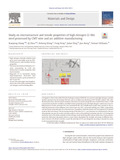JavaScript is disabled for your browser. Some features of this site may not work without it.
| dc.contributor.author | Zhang, Xiaoyong | |
| dc.contributor.author | Zhou, Qi | |
| dc.contributor.author | Wang, Kehong | |
| dc.contributor.author | Peng, Yong | |
| dc.contributor.author | Ding, Jialuo | |
| dc.contributor.author | Kong, Jian | |
| dc.contributor.author | Williams, Stewart W. | |
| dc.date.accessioned | 2020-01-22T12:34:12Z | |
| dc.date.available | 2020-01-22T12:34:12Z | |
| dc.date.issued | 2019-01-23 | |
| dc.identifier.citation | Zhang X, Zhou Q, Wang K, et al., (2019) Study on microstructure and tensile properties of high nitrogen Cr-Mn steel processed by CMT wire and arc additive manufacturing. Materials and Design, Volume 166, March 2019, Article number 107611 | en_UK |
| dc.identifier.issn | 0264-1275 | |
| dc.identifier.uri | https://doi.org/10.1016/j.matdes.2019.107611 | |
| dc.identifier.uri | https://dspace.lib.cranfield.ac.uk/handle/1826/14989 | |
| dc.description.abstract | A designed Cr-Mn-N wire with 0.99 wt% of nitrogen content (HNS0.99) was used to make high nitrogen austenite stainless steel parts by introducing CMT wire and arc additive manufacturing (CMT-WAAM) method. The solidification behaviour, microstructure evolution, inclusions and tension properties were studied both in the as-built and post heat treatment conditions. Excellent tension properties parts with high nitrogen content were successfully produced. Ferrite-austenite (FA) and austenite-ferrite (AF) solidification models were revealed in the as-built microstructure of two different areas, inner layer area (ILA) and partial melting area (PMA), respectively, and the former predominated the microstructure. Amorphous inclusion islands and microspherical inclusions made by MnO were found. The increasing density of the latter in 0.1-1 μm diameters was detrimental to the tensile properties because the matrix-inclusion surfaces acted as the preferred nucleation sites for Cr2N during heat treatment. Due to the stable austenite and the nitrogen work hardening effect, planer dislocation-arrays predominated the dislocation slip model which, to some extent, diminished the strength anisotropy in different directions. However, the ferrite dendrites caused the diversity of UTS and elongation by acting as tunnels for cracks in the horizontal direction samples. | en_UK |
| dc.language.iso | en | en_UK |
| dc.publisher | Elsevier | en_UK |
| dc.rights | Attribution-NonCommercial-NoDerivatives 4.0 International | * |
| dc.rights.uri | http://creativecommons.org/licenses/by-nc-nd/4.0/ | * |
| dc.subject | High nitrogen Cr-Mn steel | en_UK |
| dc.subject | CMT wire and arc additive manufacturing (CMT-WAAM) | en_UK |
| dc.subject | Post heat treatment | en_UK |
| dc.subject | Solidification model | en_UK |
| dc.subject | Nitrogen work hardening | en_UK |
| dc.subject | Inclusions | en_UK |
| dc.title | Study on microstructure and tensile properties of high nitrogen Cr-Mn steel processed by CMT wire and arc additive manufacturing | en_UK |
| dc.type | Article | en_UK |
Files in this item
The following license files are associated with this item:
This item appears in the following Collection(s)
-
Staff publications (SATM) [4444]

